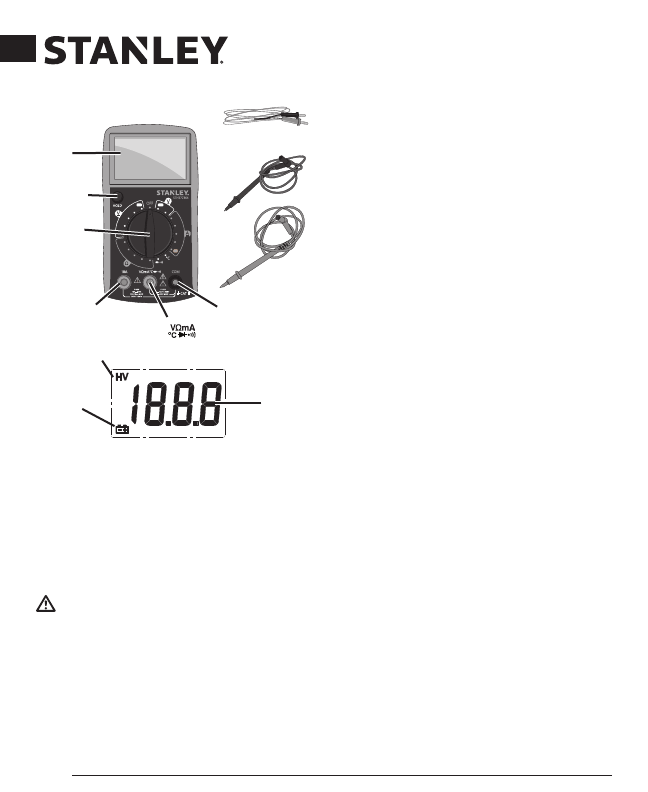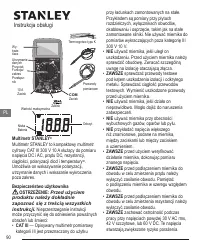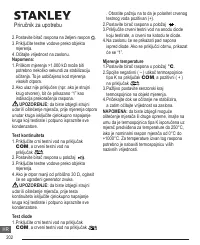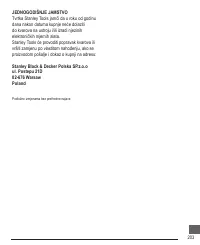Мультиметры Stanley STHT0-77364 - инструкция пользователя по применению, эксплуатации и установке на русском языке. Мы надеемся, она поможет вам решить возникшие у вас вопросы при эксплуатации техники.
Если остались вопросы, задайте их в комментариях после инструкции.
"Загружаем инструкцию", означает, что нужно подождать пока файл загрузится и можно будет его читать онлайн. Некоторые инструкции очень большие и время их появления зависит от вашей скорости интернета.

2
User Manual
GB
2000
k
200k
20k
2000 200
200
m
20m
2000
μ
200
μ
200
200
20
2000
m
200
m
300
300
10
2000k
200k
20k
2000
200
200m
20m
2000μ
200μ
200
200
20
2000m
200m
300
300
10
2000
k
200k
20k
2000 200
200
m
20m
2000
μ
200
μ
200
200
20
2000
m
200
m
300
300
10
2000
k
200k
20k
2000
200
200
m
20m
2000
μ
200
μ
200
200
20
2000
m
200
m
300
300
10
2000 k
200k
20k
2000
200
200 m
20m
2000 μ
200 μ
200
200
20
2000 m
200 m
300
300
10
2000
k
200k
20k
2000
200
200
m
20m
2000
μ
200
μ
200
200
20
2000
m
200
m
300
300
10
2000
k
200k
20k
2000 200
200
m
20m
2000
μ
200
μ
200
200
20
2000
m
200
m
300
300
10
2000k
200k
20k
2000
200
200m
20m
2000μ
200μ
200
200
20
2000m
200m
300
300
10
2000
k
200k
20k
2000 200
200
m
20m
2000
μ
200
μ
200
200
20
2000
m
200
m
300
300
10
Test Leads
Highest Value
10 A
Terminal
Function/
Range
Switch
Data Hold
Button
COM
Terminal
Terminal
Display
Low
Battery
Reading
K Type Thermocouple
STANLEY
®
Multimeter
The STANLEY Multimeter is a CAT III
300 V 10 A compact digital multimeter for
measuring DC and AC voltage, DC current,
resistance, continuity, diode polarity, and
temperature. It features polarity indication, data
hold, and overrange indication.
User Safety
WARNING:
Read and understand all
instructions before using product.
Failure to follow all instructions may result in
severe injury or death:
• CAT III – This measurement Category III
multimeter is for use on permanently installed
loads. Examples are measurements on
distribution boards, circuit breakers, wiring,
and equipment like fixed installation motors.
Do not use the meter for measurements
higher than Category III 300 V 10 A.
• DO NOT use the meter if it is damaged.
Before using the meter, inspect the case.
Pay particular attention to the insulation
surrounding the connectors.
• ALWAYS Inspect the test leads for damaged
insulation or exposed metal. Check the test
leads for continuity. Replace damaged test
leads before you use the meter.
• DO NOT use the meter if it operates
abnormally. Protection may be impaired.
• DO NOT operate the meter where explosive
gas, vapor, or dust is present.
• DO NOT apply more than the rated voltage,
as marked on the meter, between terminals or
between any terminal and earth ground.
• ALWAYS verify the meter’s operation by
measuring a known voltage before use.
• ALWAYS turn off circuit power before
connecting the meter in the circuit to measure
current. Remember to place the meter in
series with the circuit.
• ALWAYS turn off circuit power before
connecting the meter to the circuit to measure
resistance.
• ALWAYS Use caution when working with
voltage above 30 V AC rms, 42 V peak, or
60 V DC. These voltages pose an increased
shock hazard.
• ALWAYS
keep your fingers behind the finger
guards on the probes when in use.
• ALWAYS connect the common test lead
before you connect the live test lead. When
you disconnect test leads, disconnect the live
test lead first.
• ALWAYS Remove the test leads from the
meter before you open the battery cover or the
case.
• DO NOT operate the meter with the battery



























































































































































































































